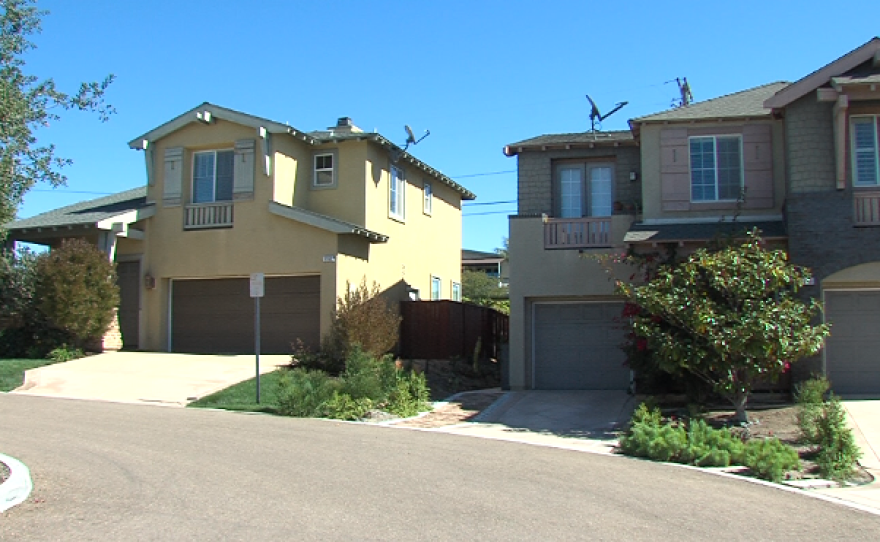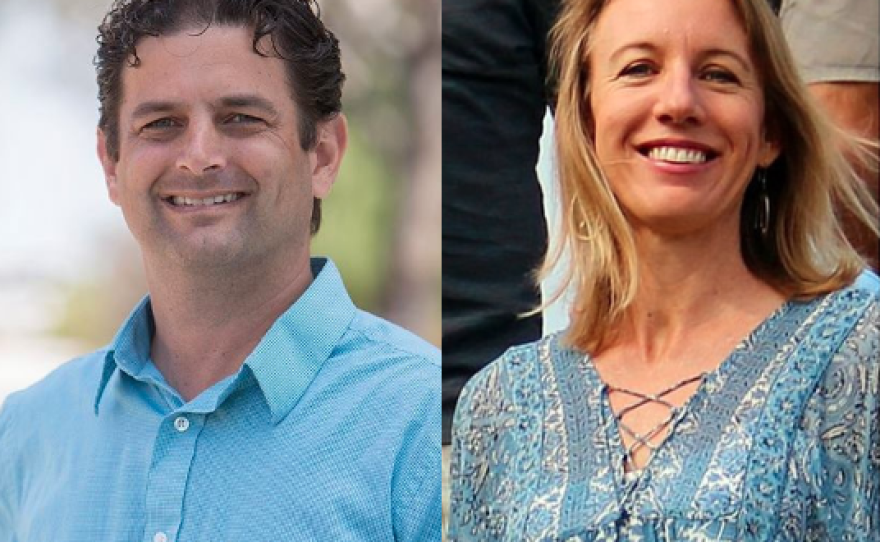Encinitas is the only city in San Diego County that does not have a state-mandated housing plan.
It is the poster child for communities fighting to keep their small-town character and resist the tide of growth. Alison St John says with measure T -- If you walk around if the need is you see signs everywhere. It is a housing plan that shows where development could happen. California law requires a local governments have a plan to meet the existing and projected housing needs of all economic sentiments of the community. Is a Neeses only city in the hole as a new County that cannot agree on a plan. If the neatest is wrestling with the future it wants. A measure tip on it& The plan and shows about a dozen sites where most development will be allowed. This whole shopping center can be knocked down and turns into 200 or 300 condominiums and they would be three-story blocks up to 48 feet tall. It is not been permitted in Encinitas is the city was incorporated 30 years ago. A Councilwoman who is running for mayor says she's reluctant to see more density but like everyone else on city Council she will vote yes on measure T. Where in the middle of three lawsuits and we have spent almost $1 million on attorney fees and settlement costs associated with the lawsuits. Those will continue. He says more lawsuits are inevitable. Paul Gasper will also vote but he says if it fails, I would work with opponents and the city to come up with a more broadly supported solution. Peter Stern says a city should go back to the drawing board. Let these things grow mature organically and by themselves. The local people should determine what type of city they would like if the city of Encinitas would allow the citizens to design a plan we would have a much more effective and passable housing element. He says the city has already spent time and money trying to come up with a better plan. We have tried again . This is the trike and. We spent almost $1 million on a plan that put a lot of the development and there was a outcry that it was unfair so we went back to the drawing board and scrap that plan and we had 140 company team meetings and this is considered the preferred alternative. I don't believe there is a better plan. What they've faced so far were found by developers. Now and environmental attorney is threatening to sue the city of -- if the measure fails. Hughes to fight to stop development projects and now he's fighting to get the development plans approved. It basically say we don't want anything that's going to change our character and unfortunately the law says you have to evolve and accommodate more growth and that means your character is going to change. The question is how was it going to change? He says he puts growth in the right places close to existing neighborhoods. He sees the decision facing Encinitas as part of a bigger dynamic facing send Eagle County. Do we say yes to development and urban areas or do we allow the proposed Hills development? We really only have two options either we sprawl into the backcountry and into the farm and are we do infill development. On any metric you can measure it is more sustainable and better for the environment than sprawl development. I see as a choice. To we sacrifice economy of a small farms are sacrifice natural resources or do we still were we are a half quarters. Novembers election is not about community character but how each community plays its part and send it was growth as a region. They were into sustainable before sustainable was cool. Ascended obese center for sustainable energy is celebrating their 20th anniversary through advocacy, education, and developing renewable energy solutions the center has been in the forefront of the effort that San Diego recently embraced in adopting the own climate action plan. Joining me is Len Hering. Welcome to the program. Thank you very much. 20 years ago where was San Diego in terms of adopting renewable energy? If you can remember back that far, California and send Eagle County was a pretty desperate place. It is the days before deregulation and power from a large-scale perspective after it occurred, prices were extremely high and things were very difficult and out of that came the San Diego regional office, which is the birthplace of the Center for sustainable energy. If you remember prices were extremely high and the governor had created almost 3 years of an emergency due to blackouts and other things that plagued our environment. That's a situation that we were born on. How far would you say the county has come in terms of renewables in the last 20 years? Remarkable. Truly San Diego is in a great place for a number of different reasons. We've had lots of good, smart community leaders. We've had cooperative IOU. So we are privileged to be in a territory in which -- it has reached the 33% goal. That's remarkable place. We are in a wonderful location for aggressive thinkers like climate action planning and renewable energy space is growing considerably. Do we still lead the state and solar energy? There's a battle between San Diego and Los Angeles. We are neck and neck and trying hard to make sure that we could be the winner. What role did the Center for sustainable energy play in this remarkable change in the last 20 years? We've had an awful lot to claim. I'm very proud of how much the center has been involved in every aspect. We've been providing great counsel and advice to virtually all of the individuals involved in the creation. We've conducted thousands of workshops and we have administered as a third-party administer for many of the large programs the veil be of solar and other things we've done a great job of putting all those together. Was the center involved in the cities climate action plan? We did have a number of individuals involved both in Council and a workshops. To help the city craft the climate action plan. We should really recognize how important the climate action plan is. San Diego is a largest city in the United States to adopt a climate action plan that has renewable energy goal within a timeframe that we all be able to remember. More importantly it was done across the aisle and the vote to accept that climate action plan was unanimous. So it really is a monumental piece and that we are very happy to be part of. We are seeing other communities around so Chula Vista along the beach, Escondido and virtually every single community has in some form or fashion a working group or a city Council who are actively engaged in adopting a climate action plan that hopefully provides for a better future for our children and grand children. That timeframe that you referred to in the city climate action plan is a goal of 100% renewables in the next 20 years. Some people say that that's not realistic. Do you know that something like that could be done? Just say in 1960 NASA scientists believe that there was an impossible mission. If you don't set the goal high enough there is nothing to attain. Is it possible? I believe that if we look at what it means to be climate action neutral, the answer is yes. Do we have the will and the behavior and the strength of modification that it will take in order to create the environment? That is yet to be seen. They will be celebrating their 20th anniversary this Thursday at liberty Station and I've been speaking with Len Hering , executive director, Center for Sustainable Energy.
Even with its back up against a legal wall, there’s plenty of opposition to Measure T — a plan for where to increase housing density in Encinitas.
If you walk around the streets of Encinitas, you’ll see signs for and against Measure T sprouting from landscaped front yards in residential areas and clogging the corners of major intersections. The coastal city is the poster child for communities fighting to keep their small-town character and resist the tide of growth.
But California law requires all local governments to have a plan, called a housing element, “to meet the existing and projected housing needs of all economic segments of the community.”
“No” on Measure T
Encinitas residents just can't seem to agree on a plan of where and how to grow. Measure T is the result of more than a year of community meetings, but attorney Peter Stern is still adamantly opposed.
“Encinitas is not bucking state law,” Stern said. “Encinitas is wrestling with the future it wants.”
Stern recently flipped through the pages of the initiative, which is the size of a small telephone book. "This whole shopping center can be knocked down and turned into 200 to 300 condominiums. They would be three-story condo blocks up to 48 feet tall," he said, pointing to drawings of multi-family condos that could replace the small shopping center near his home.
Stern said there’s no guarantee the new plan will result in any new affordable housing in Encinitas. He believes higher density will simply benefit developers’ profits.

But it’s worth noting that, even though Encinitas is the only city to break state law by not adopting a housing element, its density bonus law has resulted in more new affordable homes than in many other coastal cities.
The density bonus law allows developers to build more houses per acre if they include an affordable house. In 2014, when California cities submitted annual reports to the state on their home-building progress, Encinitas reported building nine homes for low-income families when many other coastal cities had built none.
Measure T does not mandate affordable housing be built, but it does allow for more density in a few clearly defined areas.
The plan has 13 sites where more dense development would be allowed in the future, including along parts of Highway 10I in downtown Encinitas and Leucadia. New three-story developments have not been permitted in most of Encinitas since the city was incorporated 30 years ago.
“Yes” on Measure T
Even Councilwoman Catherine Blakespear, who is running for mayor, said she is reluctant to see more density come to Encinitas. But, like everyone else on the council, she said she’d vote “yes” on Measure T.

“We’re in the middle of three lawsuits related to our lack of compliance,” she said, “and we have spent almost $1 million in attorneys’ fees and settlement fees associated with those lawsuits.”
More expensive lawsuits are sure to follow if Measure T fails, Blakespear said.
“We have a fiduciary duty not to waste taxpayer money,” she said. “We can’t have a city that says, ‘We’re going to close the door and not let anybody else come.'"
Blakespear’s challenger in the mayor’s race, Paul Gaspar, said in an email he will also vote yes on Measure T.
“Measure T is certainly not perfect, but I plan to vote for it because of the likely consequences should it fail. Should Measure T fail, I will work with its opponents, the City, and the leadership in Sacramento to come up with a more broadly supported solution to come into compliance with legislative intent and state law.”
Attorney Stern wants the city to go back to the drawing board.
“Keep Leucadia funky,” he said. “Let these things mature organically by themselves, not be centrally planned by university planners who like making cookie-cutter shopping centers and block buildings and designs. The local people should determine what type of city they would like.”
But Blakespear said the city has already spent time and money trying to come up with a better plan.
“I just don’t think there is a better plan,” she said, “We have tried again. This is the ‘try again.’ We spent almost ($1 million) on a consultant’s plan that put a lot of the new development on El Camino Real and there was an outcry that it was unfair, so we went back to the drawing board, scrapped that plan and we had 140 community meetings. This is considered the environmentally preferred alternative.”
Blakespear said the plan adopted in Measure T was analyzed to result in the least amount of extra traffic. Plus, it adds the density almost equally throughout the five distinct communities of Old and New Encinitas, Leucadia, Olivenhain and Cardiff-by-the-Sea.
The Building Industry Association and DCM Properties filed successful lawsuits against the city for failing to agree on a housing plan. And an environmental attorney, Marco Gonzalez of Coast Law Group, is threatening to sue Encinitas if Measure T fails.
Gonzalez said he used to fight to stop development projects, but now he’s fighting to get good development plans approved.
“Folks who are against Measure T say, ‘We don’t want anything that’s going to change our character,’ and unfortunately the law says you have to evolve, you have accommodate more growth,” Gonzlaez said. “That means your character is going to change. Now the questions is: How is it going to change?”
Gonzalez said Measure T puts growth in the right places: close to existing main roads and the railway line.
The bigger issue
More importantly, Gonzalez said, the decision facing Encinitas is part of a bigger dilemma facing San Diego County: Do voters say “yes” to development in urban areas like Encinitas, or do they allow sprawl, like the proposed Measure B, which would allow the development of Lilac Hills in Valley Center? Both measures are on November’s ballot.
"We really only have two choices," Gonzalez said. “Either we sprawl into the backcountry, or we do infill development. On any metric you could possibly measure, infill development is more sustainable and better for the environment than in sprawl development.
“So I see it as a choice,” Gonzalez continued. “Do we sacrifice the economy of our small farms in the backcountry, do we sacrifice the natural resources of the Cleveland National Forest, or do we infill where we already have transit corridors?”
What voters decide on measures T and B in November could be an indication of the direction that San Diego takes as the region continues to grow.






